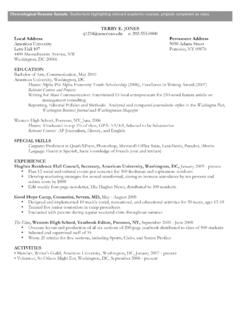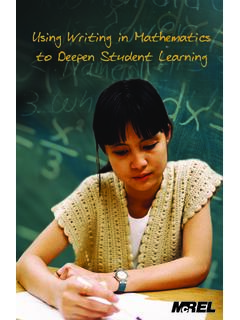Transcription of Using Assistive Technology Tools to Support Learning in ...
1 Using Assistive Technology Tools to Support Learning in the Inclusive Preschool Classroom Marla J. Lohmann Colorado Christian University Katrina A. Hovey Western Oregon University Ariane N. Gauvreau University of Washington Johanna P. Higgins University of nebraska - Lincoln For over a century, early childhood experts have discussed the importance of play for young children s growth and development. Play is critical for the development of young children as it increases Learning (Barton, 2015), supports young children in gaining social and communication skills (Dennis & Stockall, 2015), and leads to social awareness and empathy skills (Brown, 2009).
2 However, for young children with disabilities, accessing play and social interactions can prove to be challenging (Fallon & MacCobb, 2013). In order to Support preschoolers with disabilities in Learning through play, the authors recommend the use of Assistive technologies (AT) for (a) communication, (b) mobility, and (c) independence. This article presents information about specific Assistive Technology devices and supports in each of these three areas. Keywords: Assistive Technology , early childhood, inclusion, play, preschool Over half of all preschoolers with disabilities are currently receiving instruction in the inclusive classroom (Lawrence, Smith, & Banerjee, 2016; Odom, 2000; Odom, Buysse, & Soukakou, 2011).
3 The literature has identified the benefits of including young children with disabilities in the preschool classroom. These benefits include reductions in challenging behaviors (Odom, 2000), increased academic Learning (Lawrence et al., 2016; Odom, 2000; Weiland, 2016), emotional competence (Weiland, 2016), communication skills (Lawrence et al., 2016; Odom et al., 2011), social gains for typically developing peers (Lawrence et al., 2016; Odom, 2000; Yu, Ostrosky, & Fowler, 2012), and a reduction in programming costs (Odom et al., 2001). In order to ensure that young children with disabilities receive the most benefit from inclusion, it is critical to provide Learning supports to meet their needs.
4 Because play Vol. 8(2) September 2019 THE JOURNAL OF SPECIAL EDUCATION APPRENTICESHIP, 8(2) 2 skills are a significant component of preschool Learning , early childhood special educators must be prepared to provide accommodations that assist young children in play. This article provides a brief overview of Assistive technologies that can be used to Support play for children with disabilities in the inclusive classroom. Importance of Play For over a century, early childhood experts have discussed the importance of play for young children s growth and development. Play is a powerful and critical vehicle for building communication skills in young children, and play provides children opportunities to communicate with peers and adults (Golinkoff & Hirsh-Pasek, 2016).
5 Through play, children gain social, emotional, physical, and cognitive skills (Ginsburg, the Committee on Communications, & the Committee on Psychosocial Aspects of Child and Family Health, 2007). John Dewey (1916) explained that children learn about the world through natural play. According to Friedrich Froebeli, often referred to as the father of kindergarten, children learn how to work together and gain self-control through play (Platz & Arellano, 2011). Maria Montessori built on this research by advocating for the need for young children to be active participants in their own Learning through real-world play and natural discovery (Edwards, 2002; Platz & Arellano, 2011).
6 Play is critical for the development of young children as it increases Learning (Barton, 2015), supports young children in gaining social and communication skills (Dennis & Stockall, 2015), and leads to social awareness and empathy skills (Brown, 2009). Due to its importance in children s development, the United Nations Commission on Human Rights has declared play as a basic human right for all children (Ginsburg et al., 2007). It is clear that play is critical for all children. However, for young children with disabilities, accessing play and social interactions can prove to be challenging (Fallon & MacCobb, 2013) due to physical, cognitive, and/or communication barriers.
7 In order to Support preschoolers with disabilities in play, the authors recommend the use of Assistive technologies for (a) communication, (b) mobility, and (c) independence. This article presents information about specific AT devices and supports in each of these three areas. Overview of Assistive Technology Under the federal guidelines outlined in the Individuals with Disabilities Education Act (IDEA; 2004), Assistive Technology (AT) is defined as any item, piece of equipment, or product system, whether acquired commercially off the shelf, modified, or customized, that is used to increase, maintain, or improve the functional capabilities of a child with a disability.
8 The use of Assistive Technology aids children with disabilities in meeting the same outcomes as their typically developing peers (Puckett, 2005). In the inclusive early childhood classroom, Assistive technologies can be used to Support a variety of skills, including play skills and interactions with peers. Inclusive preschool teachers are encouraged to create a universally designed Learning environment in which all children can participate and be engaged (Horn, Palmer, Butera, & Lieber, 2016). The research literature supports the use of several types of AT, ranging from low-to-high tech, to increase movement in children with motor delays and access to the early Learning curriculum.
9 While the research that supports use and consideration of AT is mandated under IDEA, there currently is no THE JOURNAL OF SPECIAL EDUCATION APPRENTICESHIP, 8(2) 3 federal requirement for the AT consideration process and many states have developed their own process or are Using the Wisconsin Assistive Technology Initiative Assistive Technology Consideration Guide (IRIS, 2019). Guidelines and Recommend Practices The use of Assistive Technology in the inclusive preschool classroom is supported by best practices in instruction as outlined by a variety of professional organizations. The National Association for the Education of Young Children (NAEYC) created the Developmentally Appropriate Practice (DAP) guidelines in order to provide a framework for supporting the Learning needs of children from birth to age 8 (NAEYC, 2009).
10 Similarly, the Division for Early Childhood (DEC) of the council for Exceptional Children published the Recommended Practices to identify evidence-based practices for supporting young children with disabilities (DEC, 2014). Finally, the council for Exceptional Children (CEC) and the Collaboration for Effective Educator Development, Accountability, and Reform (CEEDAR) Center released a document outlining the High Leverage Practices (HLPs), which are teaching practices that lead to positive outcomes for children with disabilities (McLeskey et al., 2017). The specific alignment with each of these sets of guidelines is identified with a figure in each section of this article.
















